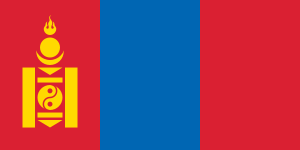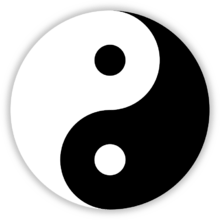Yin and yang facts for kids

The Taijitu (太极图), more commonly referred to as Yin and Yang, is a Chinese symbol from a belief system called Taoism. It is also stylized as Yinyang or Yin-Yang. It represents the idea that nature is made up of opposing, yet complementary forces and energy. The traditional symbol has two opposite colors, White (Yang) and Black (Yin). Both sides contain the opposite color inside of itself to represent the main idea of dualism. Some examples of these balanced opposites are: Light and Dark, Male and Female, Expansion and Contraction, Up and Down, Sun and Moon, and Movement and Rest. Yin and Yang are interchangeable with one another, so Yang can become Yin. The Yin-Yang duality also applies to how people should live their lives. The belief is that we should not have too much or too little of something, such as food for example. While food is essential to life and survival, eating too much can cause health problems, while too little causes starvation.
Alternative and holistic medicine includes the Yin-Yang dualism and has grown in popularity in the western world. The symbol and ideas of oftentimes portrayed in daily life, such as in movies or artwork.
Science includes that ideal of dualism in some areas as well. Magnets require both north and south poles for it to be functional and to move. In chemistry, protons can be represented by Yang and electrons can be represented by Yin.
Yin and Yang in everyday life
The principles of Yin and Yang can be applied to many aspects of life:
- Health: Traditional Chinese Medicine uses Yin and Yang to understand health and illness. Imbalances in Yin and Yang are believed to cause illness. Restorative practices like sleep and relaxation are considered Yin, while exercise and activity are considered Yang.
- Relationships: Healthy relationships involve a balance of giving and receiving, activity and rest, independence and togetherness. These are all aspects of Yin and Yang.
- Food: Some foods are considered Yin (cooling) and others Yang (warming). A balanced diet includes both.
- Seasons: Winter is considered Yin (cold, dark, passive), while summer is considered Yang (hot, bright, active). Spring and Autumn are transitional seasons, representing the balance between Yin and Yang.
- Emotions: Even our emotions can be understood through the lens of Yin and Yang. Joy and excitement are Yang, while calmness and peace are Yin.
See also
 In Spanish: Yin y yang para niños
In Spanish: Yin y yang para niños


